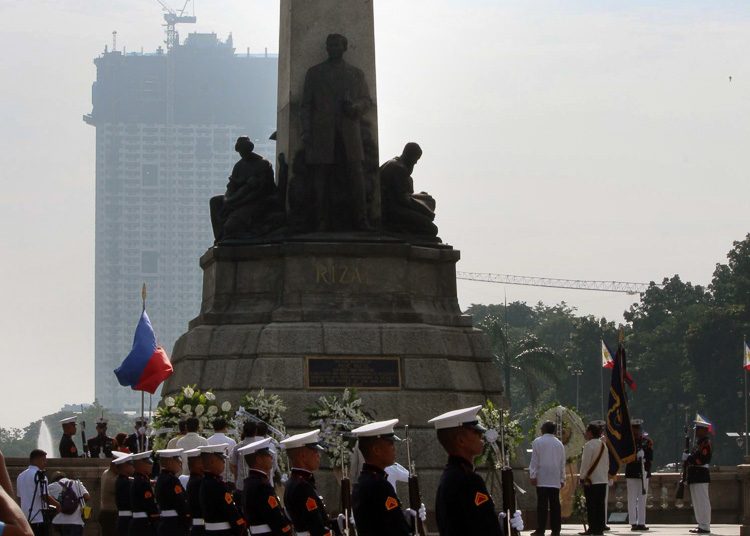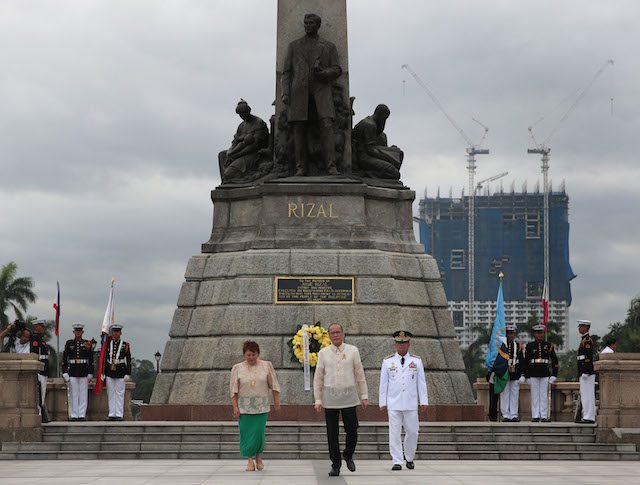SUMMARY
This is AI generated summarization, which may have errors. For context, always refer to the full article.

MANILA, Philippines – Does the constitutional mandate to protect cultural properties extend to their vista or sightline?
The counsel for the developer of the controversial Torre de Manila condominium and a Supreme Court (SC) justice clashed on a question of interpretation during the second round of oral arguments on Tuesday, August 4, on the petition filed by the Knights of Rizal against the 49-story residential project in Manila.
The group wants to stop the construction of Torre de Manila because it mars the sightline of the historic Rizal Monument, a protected cultural property.
Victor Lazatin, counsel for real estate developer DMCI Homes, argued that constitutional provisions on the protection of heritage sites cover only the cultural properties themselves, “but not including the background or the vicinity.”
He pointed out that while the Constitution mandates the state to “conserve, promote, and popularize the nation’s historical and cultural heritage and resources,” it does not specifically mention the inclusion of a cultural property’s sightline or vista.
While SC Associate Justice Francis Jardeleza acknowledged this, he also said that the Court must now decide on laying down the definition of the term “conserve” as stated in the Constitution.
“We now have to decide this legal issue of whether the constitutional provision of conservation also includes sightline and other terms,” he said.
But during the hours-long interpellation, Jardeleza and Lazatin repeatedly disagreed on this point: Lazatin argued that the term “conserve” should be understood in its ordinary meaning, while the SC justice said that it should be understood in the context of the worldwide heritage conservation movement during the time that the 1987 Constitution was ratified.
Defining ‘conservation’
For Jardeleza, the framers of the Constitution referred to conservation with a technical meaning in mind. The SC justice cited various heritage conservation charters and conventions that the Philippines participated in.
“From 1931 to 1987, the world conservation movement had a technical meaning for conservation, including the sightline, vista, and all the other terms,” Jardeleza said.
“Monuments, in the special language of heritage conservation, is given special protection,” he added.
Because of this, the magistrate disagreed with Lazatin’s insistence that the term should not be given a special or technical meaning.
“Heritage conservation has a term of its own, so you cannot use ordinary language. You have to use it in context of heritage conservation,” Jardeleza said.
To further stress his point, the SC justice cited Republic Act 10066, or the National Cultural Heritage Act of 2009.
Jardeleza said that the Rizal Monument falls under “built heritage” as defined in Section 3(f) of RA 100066:
“Built heritage” shall refer to architectural and engineering structures such as, but not limited to, bridges, government buildings, houses of ancestry, traditional dwellings, quartels, train stations, lighthouses, small ports, educational, technological and industrial complexes, and their settings, and landscapes with notable historical and cultural significance.
“The Rizal Monument is a built heritage entitled to protection, and the laws refer to setting and landscapes in support of my argument that you cannot take a restrictive view,” Jardeleza said.
Lazatin, however, disagreed, saying that the historic monument does not fall under “architectural and engineering structures.”
“Certainly a monument does not fall under the architectural and engineering structures. A monument is usually considered as a work of art more than an engineering structure,” he said.

‘Invading’ the landmark
In his defense of the condominium, Lazatin repeatedly stressed that Torre de Manila does not alter the physical integrity of the Rizal Monument since the housing project sits on private property well outside the protected buffer zone of the park.
This was also one of the basis behind DMCI’s opposition to the cease and desist order issued by the National Commission for Culture and the Arts against the project.
Jardeleza, however, argued that even if there was no physical contact, Torre de Manila was already trespassing on the monument’s line of sight.
“That’s why Torre, they call it a ‘photobomb’ because without touching the monument, it is invading the landmark,” Jardeleza said, referring to the disparaging term hurled by critics of the project against the building, which can be clearly seen rising behind the monument of the national hero.
But Lazatin again took issue with this, arguing that the extent of the sightline is not defined.
“The law already provided a 5-meter buffer zone. Are we, by judicial legislation, going to extend? For how long, how far? What are the guidelines?” he asked.
He earlier proposed setting guidelines on such issues through the creation of a zoning law, “not by judicial discretion.”
On July 21, SC magistrates held the first round of hearings, repeatedly grilling the Knights of Rizal counsel, William Jasarino, to identify what laws Torre de Manila supposedly violated and to provide evidence that the building was built “in bad faith.”
Several SC justices also took exception to the petitioner’s move of elevating their petition to the High Court and skipping the lower trial courts.
After more than 4 hours of interpellation, the second round of hearings was adjourned. Oral arguments on the case will be continued on August 11. – Rappler.com
Add a comment
How does this make you feel?
There are no comments yet. Add your comment to start the conversation.